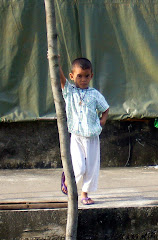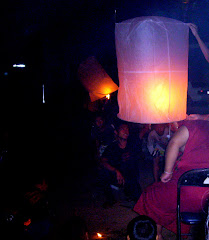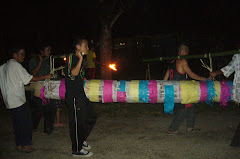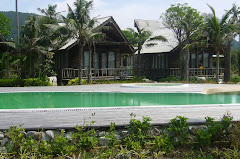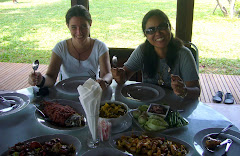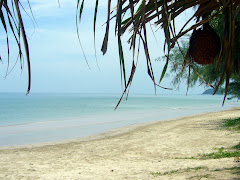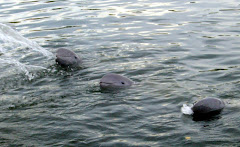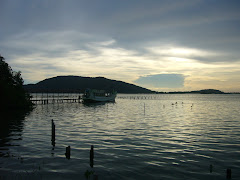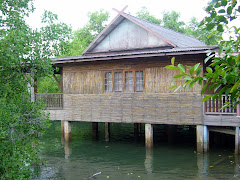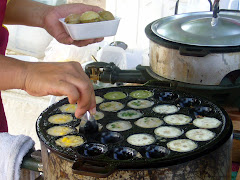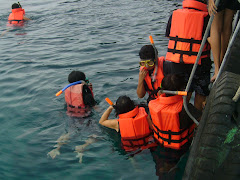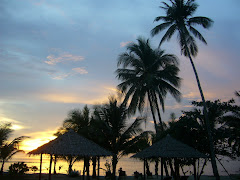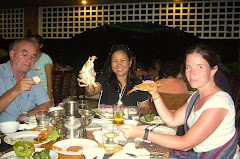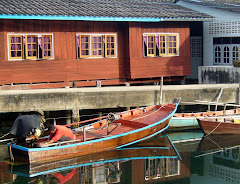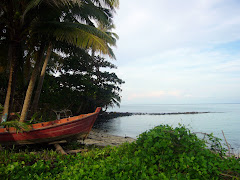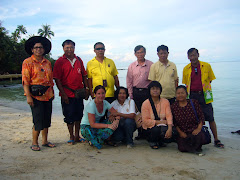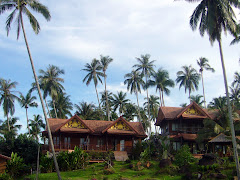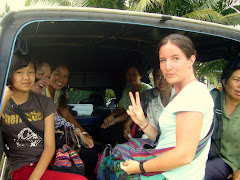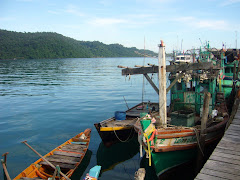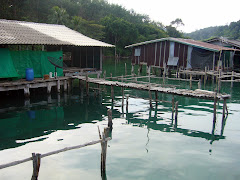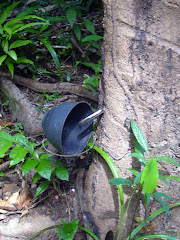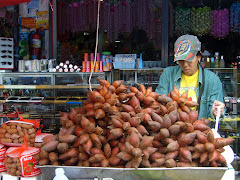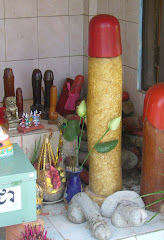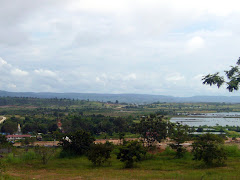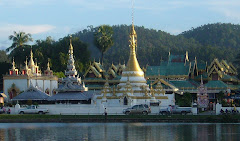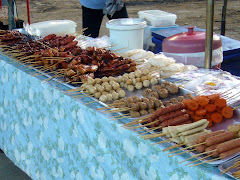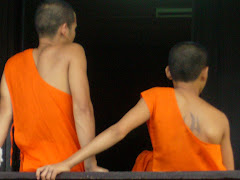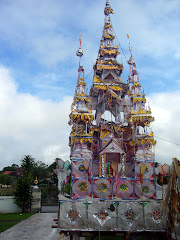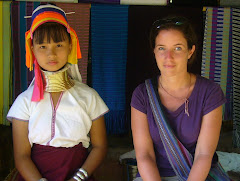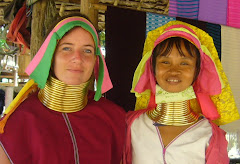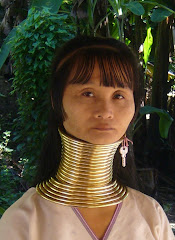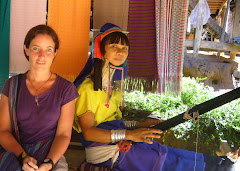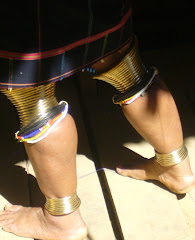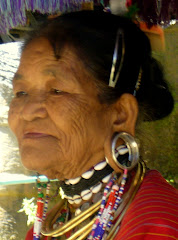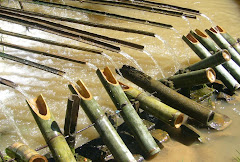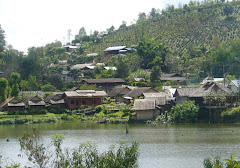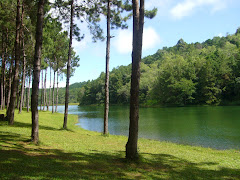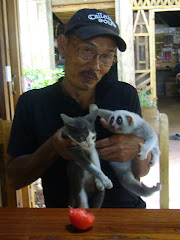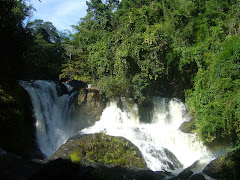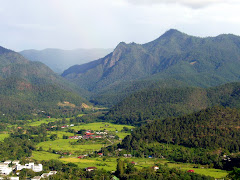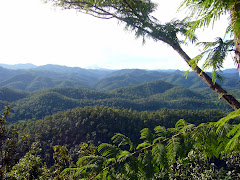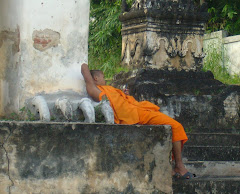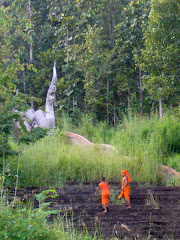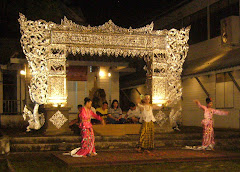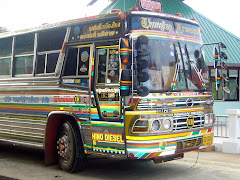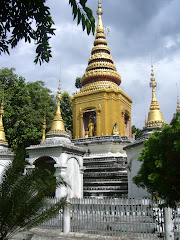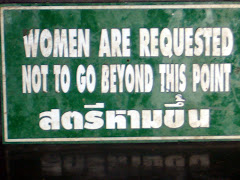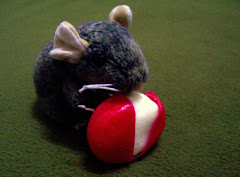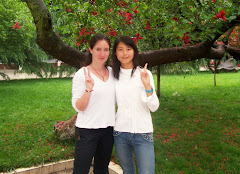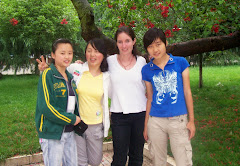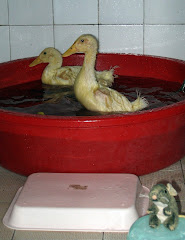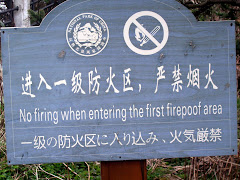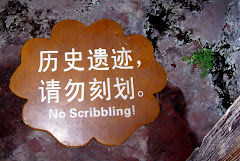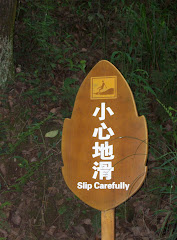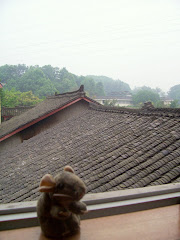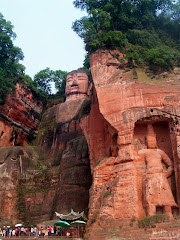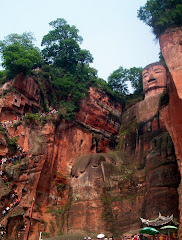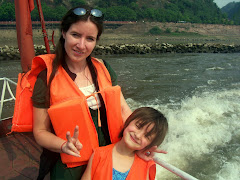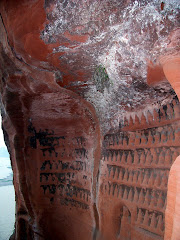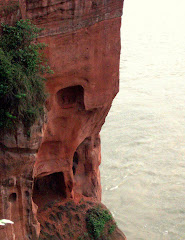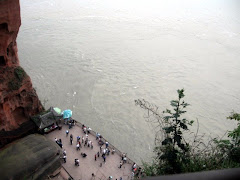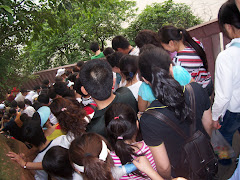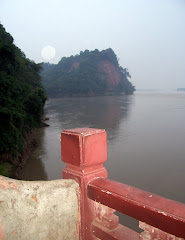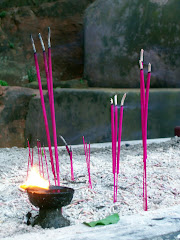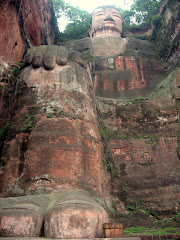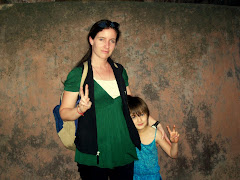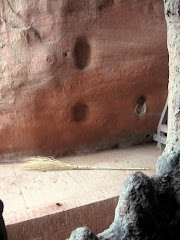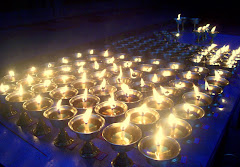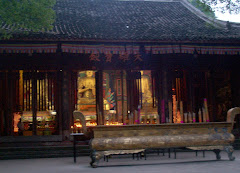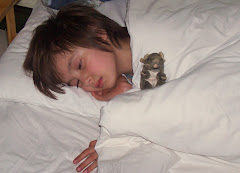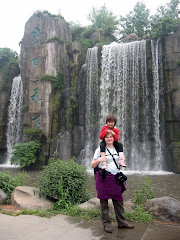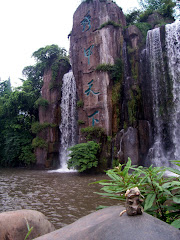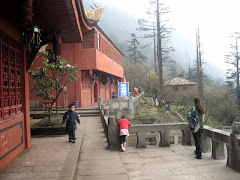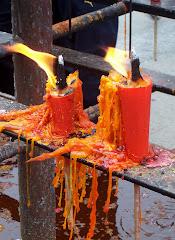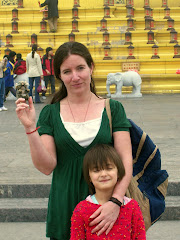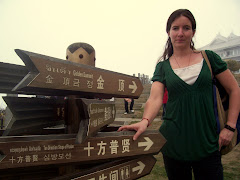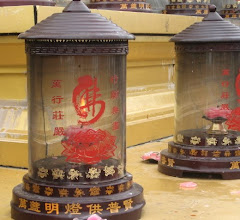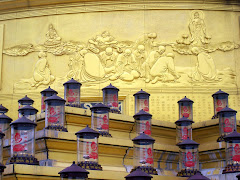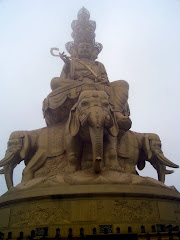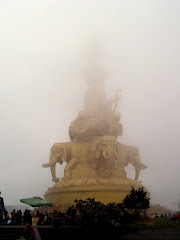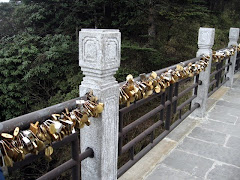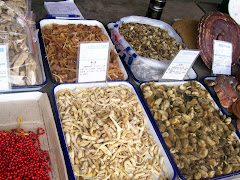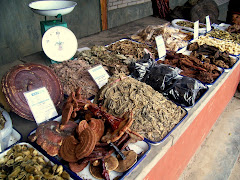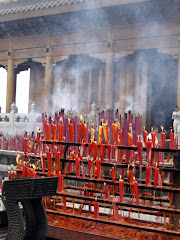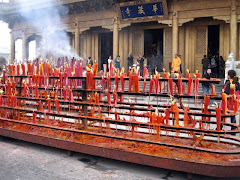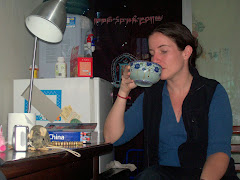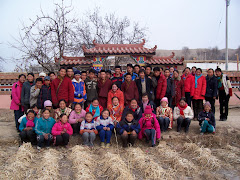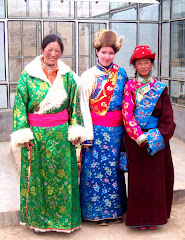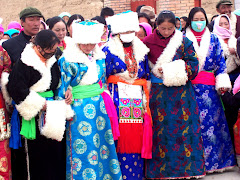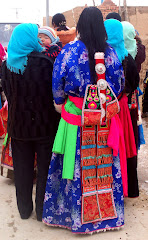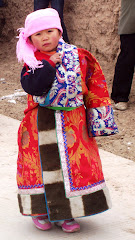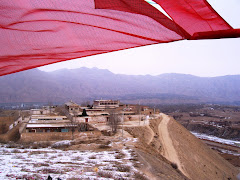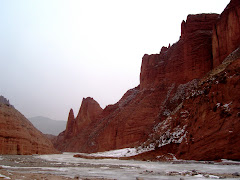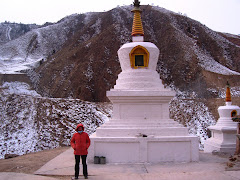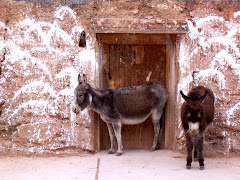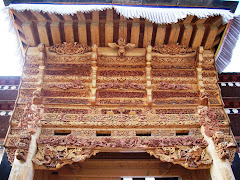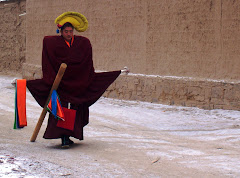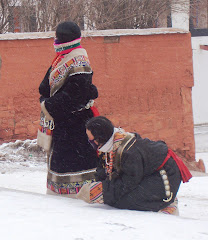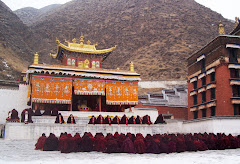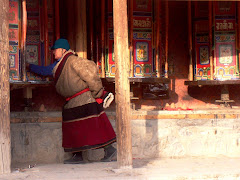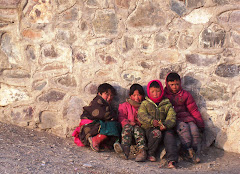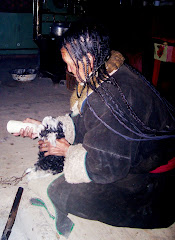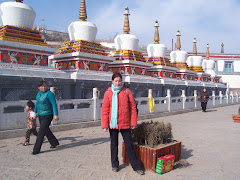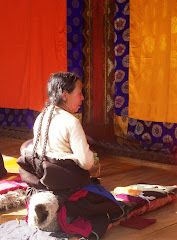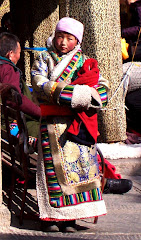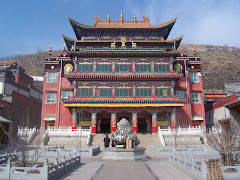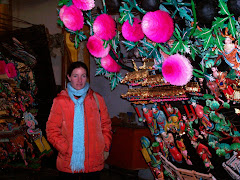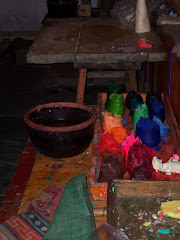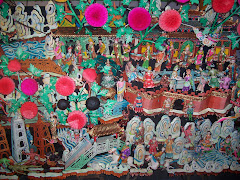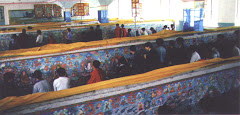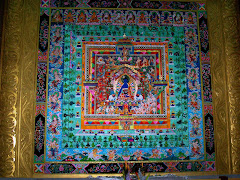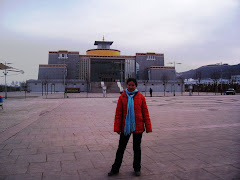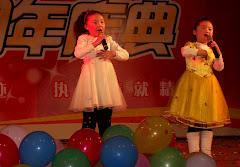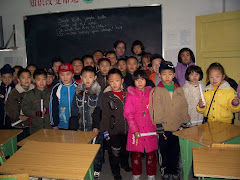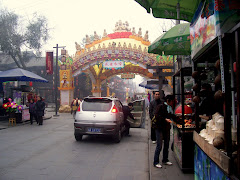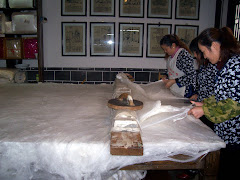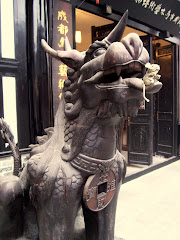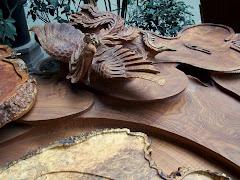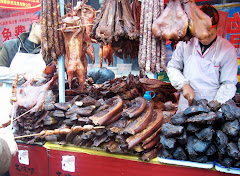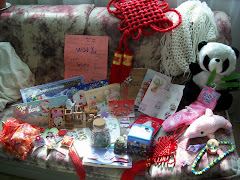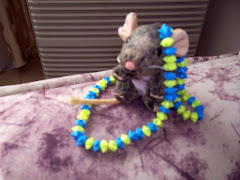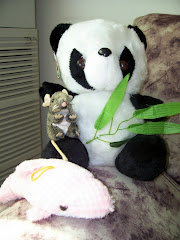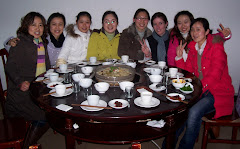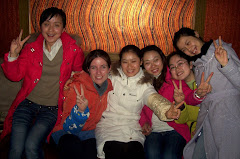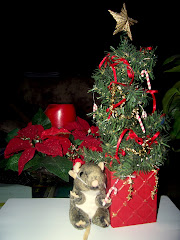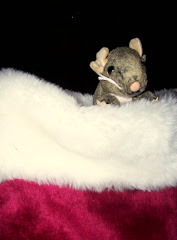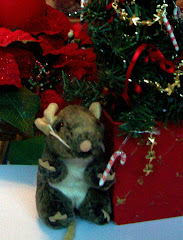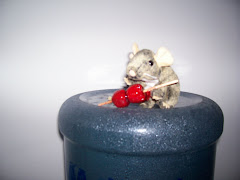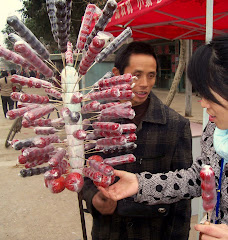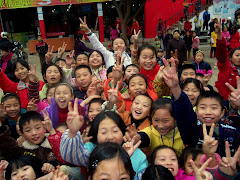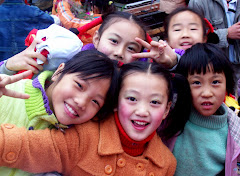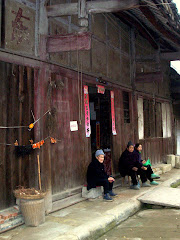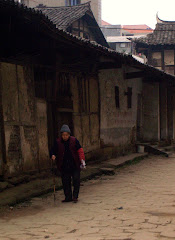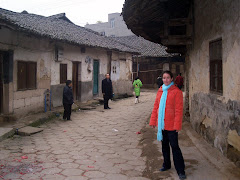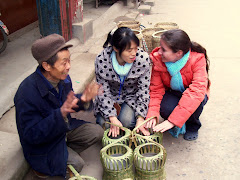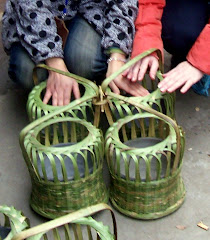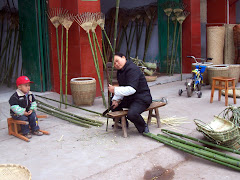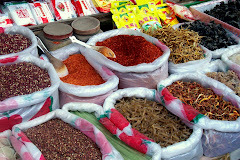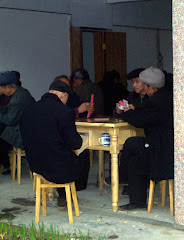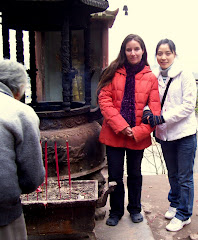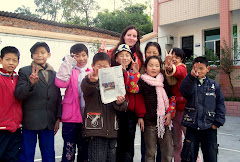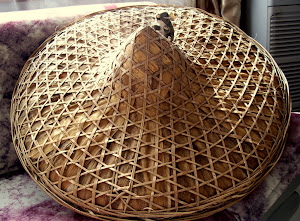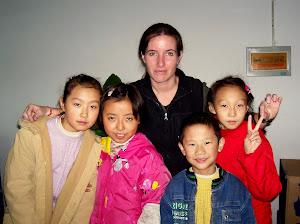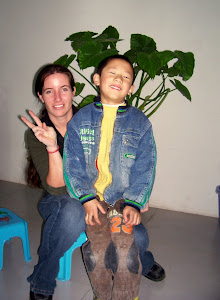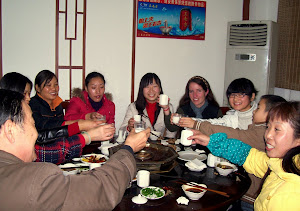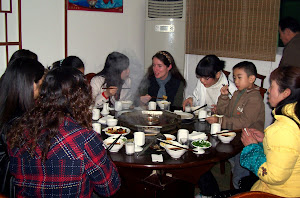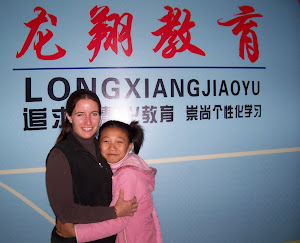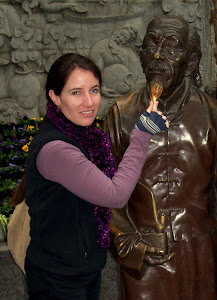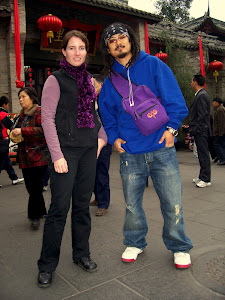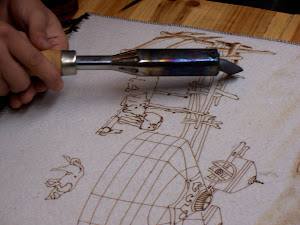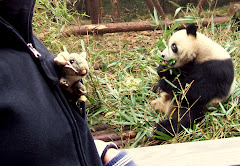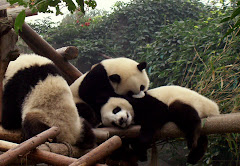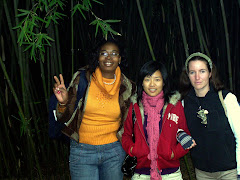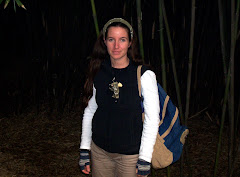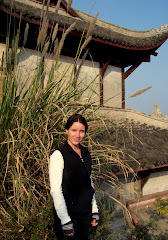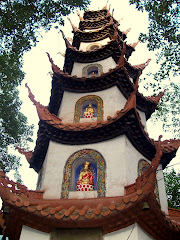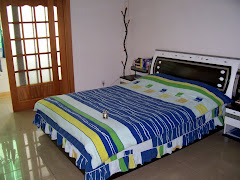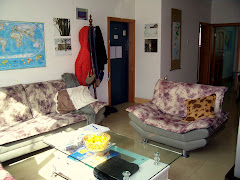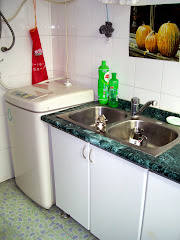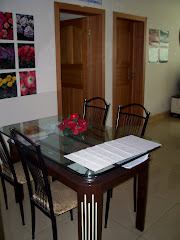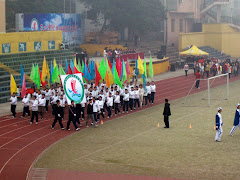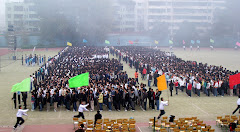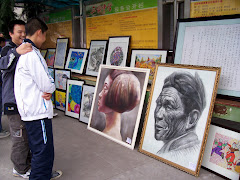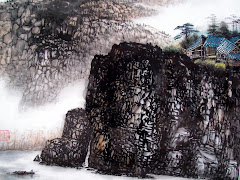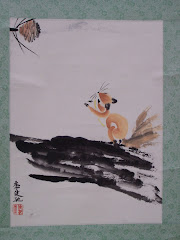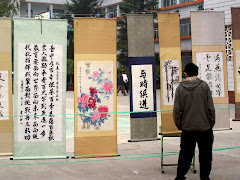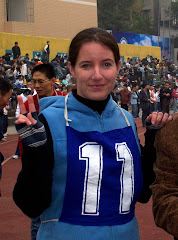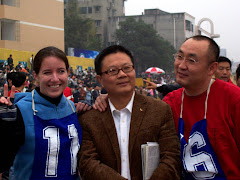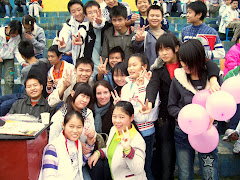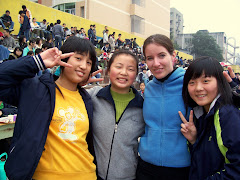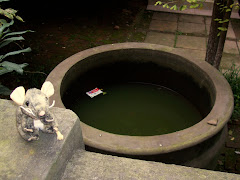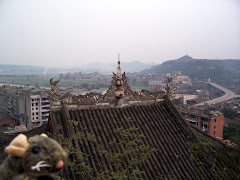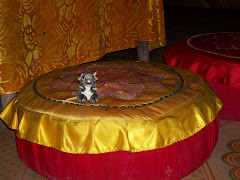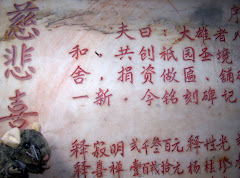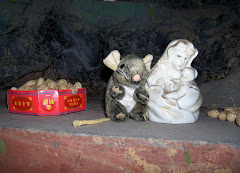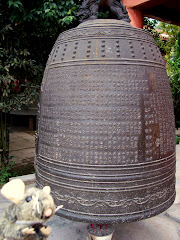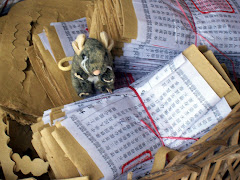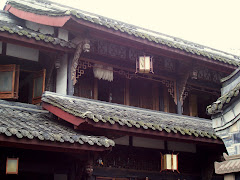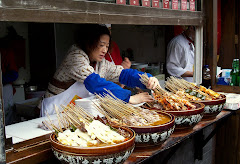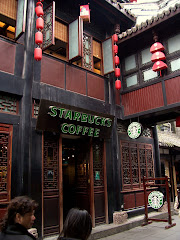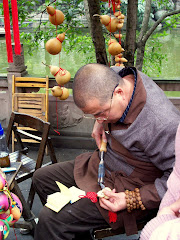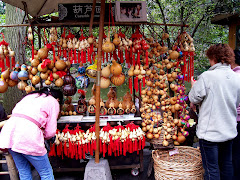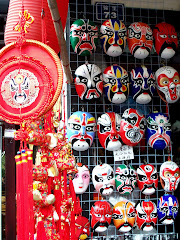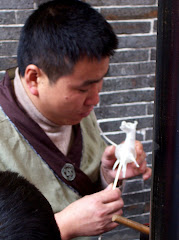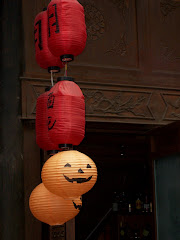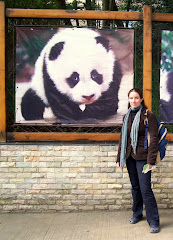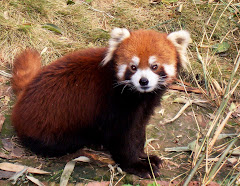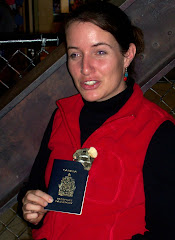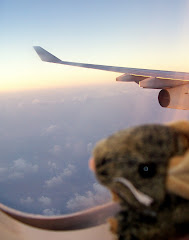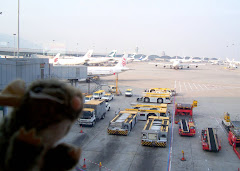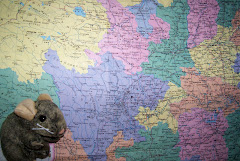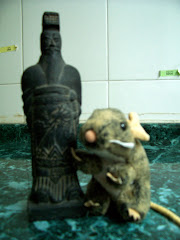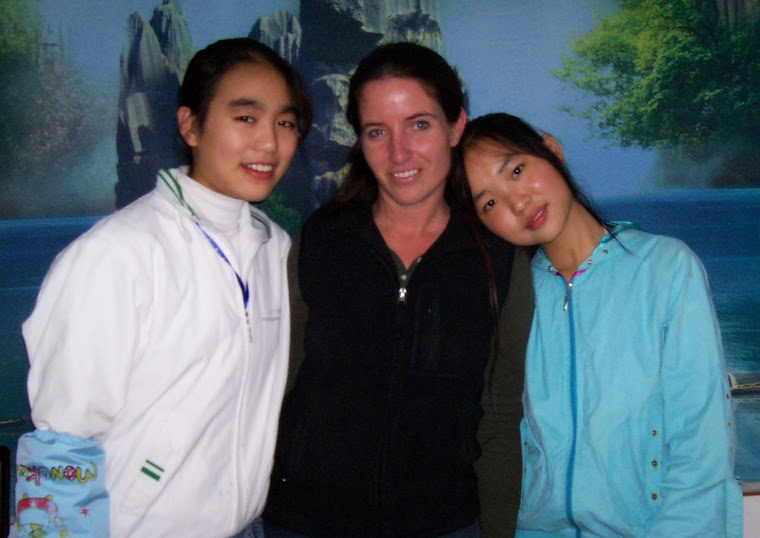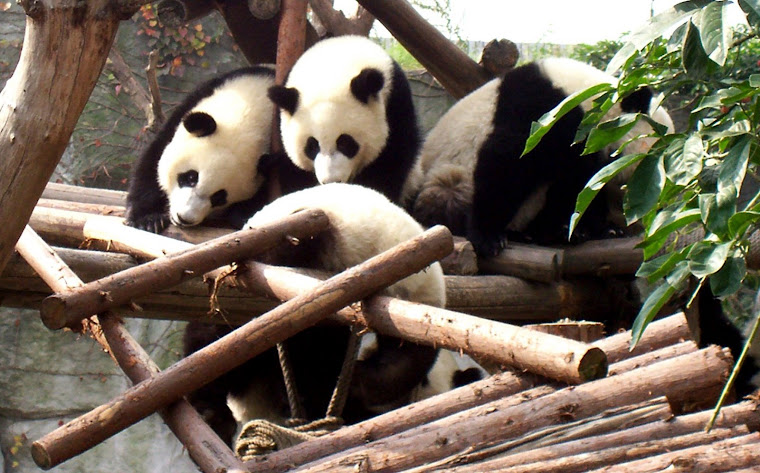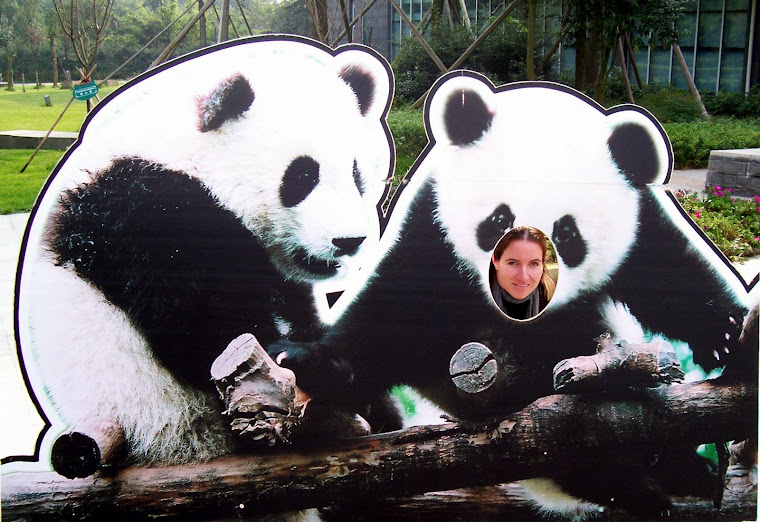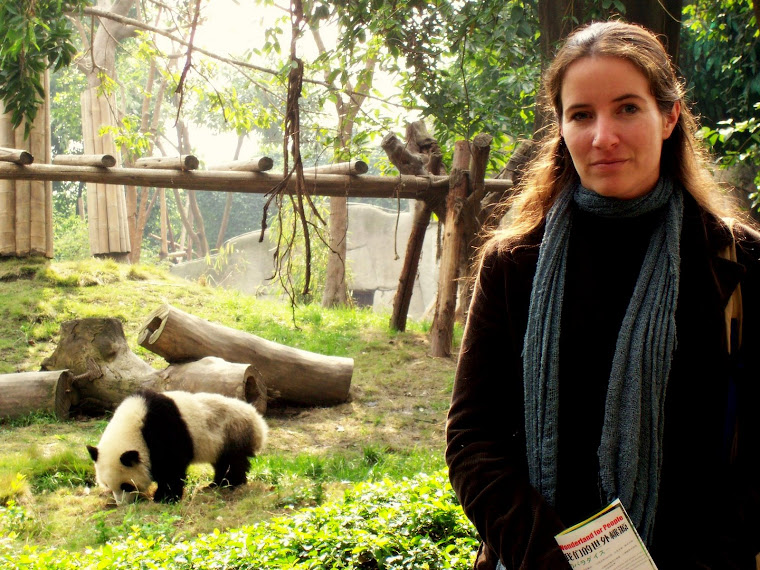It's been quite an eventful two weeks since the first big earthquake on May 12th. Even now, everyone s asking each other, "so where weere you when it happened?". After going to Chengdu to see my friends Yeshi and Machig off at the airport, as they left for Hong Kong, I ended up staying for a week, doing volunteer work for the Red Cross. Mostly unloading and reloading trucks of supplies for the quake areas, medicines, food, bedding, tents and water mostly. There were loads of volunteers, mostly university students, but there were a few foreigners as well. Most days I went with Florian, a German guy staying at the same hostel as me. Some days there were so many people that we just got in each other's way. On those days I left early, but a couple days there was a shortage of volunteers, and it was hard bloody work. Especially the day we had to unload and reload several trucks of noodles. They were really heavy, and my forearms are stll bruised from hauling them. But it was good to be doing something at least. The first day, there were hundreds of injured people lying on stretchers outside the hospital, waiting to be transferred to other hospitals around China. Lots of kids. Any natural disaster forces one to realign one's priorities, I think. One of the silver linings I guess, along with the ability of people to voluteer time effort and money to help those suffering.
Headed back to Santai on Sunday the 25th, as classes were due to restart on the 26th. So I headed off quite happily on the bus, got back to my flat, got unpacked, and then another earthquake. 6.4 on the Richter scale apparently. Guess whoever is planning this earthquake scheme realised I was back... So out we all went to the playground again, and noone slept inside that night. School was delayed yet again the next day, to start Tuesday instead, assuming no more earthquakes happen.
Just to make life "interesting" (as if it wasn't interesting enough already!) there are now warnings of a flood. There is a dam up near Bechuan, where a normally small lake has been unnaturally enlarged by the quake rerouting a few rivers, and there are doubts the water can be controlled. If that dam bursts, it will flood the river basin down past Mianyang to Santai. Santai lies in an S curve of that particular river. Wonderful. So there have been announcements periodically over the last few days about the status of the dam, and a sample of the warning siren, so we'll know when we hear it to run for the hills! However, it's said we'll have about 6 hours here in which to get to higher ground if the dam bursts. Everyone has been told to stock up on food and water, just in case.
Classes did begin Tuesday, though we've had a few smaller tremors in the past couple days, and had to get all the kids out of the classrooms. I feel sorry for the kids, there's no way they can concentrate on their lessons. And many of them are tired, since noone is sleeping well, always half alert for tremors. Teachers are sleeping in the dorms with the kids, in case they need to be evacuated at night. The novelty of this whole quake thing has really worn off!
Have only three classes to teach tomorrow morning, and then I'm off in the afternoon! What are the chances of another earthquake or flood before noon tomorrow? Guess I shouldn't tempt fate... If all goes well, I plan to leave here at noon, catch a bus to Chengdu and sort out my travel plans from there, train or bus tickets, whatever. Then up to Amdo again! It'll be hard to get to an internet connection as well, so it may be a while before I can update this, but check periodically!
Meanwhile, here are a few pictures of friends and students....
Thursday, May 29, 2008
Thursday, May 15, 2008
Epics and Earthquakes May 2008
Considering March and April passed relatively uneventfully, May is making up for it in spades….After my trip to Leshan and Emei Shan at the beginning of the month, I settled down to preparing and teaching classes for my final month of this term. Then my friend Yeshi and her daughter Machig called to say they were coming up to visit for the following weekend.
Arriving the Friday evening, we went out for a gallivant with a bunch of teachers and their families on the Saturday to a nearby village called Pi Pa Yuan. Riding a battered old bus with rattling wooden seats up the winding roads into the surrounding hills, we drove past fields of wheat, rice and vegetables until the bus stopped to let us off seemingly in the middle of nowhere. The teachers set off down a curving path through an orchard of pi pa trees, the fruit for which the village is named. I haven’t seen them elsewhere, and doubt there’s an English name, but the fruit is small and orange-yellow, with several smooth pits inside. They look a bit like small mangoes, but are more sour. We carried on through the orchard til we reached a tea house set among the trees, its two floors built of wood and open on all sides to the breezes. Before sitting down for tea, we wandered among the orchards, chasing butterflies and enjoying the break from town and city life, especially Yeshi, who lives in the polluted metropolis of Chengdu. We walked out to the terraced fields and watched the local farmers harvesting rapeseed, and watering other crops. It could have been 100 years ago, with the farmers bright specks of colour among the fields of wheat and rice, large round hats protecting them from the sun. After a while, we returned to lounge in the shade in the terrace, sipping green tea and enjoying the cool breeze for a few hours before lunch. This turned out to be a veritable feast, all sorts of traditional delicacies. Finally mid afternoon, we returned to Santai for a quiet evening. The next day, we went out across the river to visit the Dong Shan park and the large Buddha statue in the cliff-side there. Not as big as Leshan, of course, but with a very serene expression on its face. Nearby, there was another large statue of Kwan Yin, the Chinese equivalent of Chenresig, the deity representing compassion, along with two other statues of the Chinese versions of Jampelyang (wisdom) and Chana Dorje (power). Wandered around for a bit by the river, watching some men fish with a long silken net strung between two long poles before returning to the town for lunch, so Yeshi and Machig could catch the bus back to Chengdu. A lovely weekend, and the weather was perfect.
So, back to classes as usual on Monday, expecting a typical week. Things started out normally enough, taught two classes Monday morning, and then was sitting at home in the early afternoon before my final class preparing some lessons for the next week, when suddenly the building started to shake violently back and forth, stuff fell off shelves, and a couple windows broke. Earthquake. Hearing the shouts and screams of my neighbours, I too dashed downstairs ( my flat is on the 5th floor), holding the railing as the building continued to sway and shake. Everyone was running out to the football ground, and my first concern was the students, as there are 8-9000 of them packed into two buildings, of 6 floors each, and it was obviously going to take some time to get them all out safely. Meanwhile, the ground continued to shake, making one feel oddly seasick and nauseous. Finally, everyone was out, and the tremor stopped, but everywhere people were crying and shouting, trying to find family and friends in the crowd. To make matters worse, the phone lines were either down or bogged down by people trying to contact their families to find out if they were alright. Many students were dizzy and nauseous, many of them fainting, and having to be carried over to the shade. There were a few more tremors, though not as strong as the first, and talking to students, I heard that in the panic, a few students had leapt out the windows of the 3rd and 4th floors, several of whom were taken to the hospital, some with broken limbs, and one girl with a serious head injury, was rushed to the big surgical hospital in Mianyang, an hour away. For the most part, though, teachers had done an excellent job in controlling the situation, and getting the students out safely. The last earthquake in this area was in 1976, so none of the students had experienced an earthquake before and were understandably terrified. We all spent the rest of that afternoon out on the football field, as the tremors continued. It was very hot, but the school arranged to have water bottles handed out to everyone. Finally students settled down, were organized in groups according to their classes and we commenced the wait to find out what we were to do next. Eventually we heard how bad the earthquake had been, and that thousands of people in a nearby town had been killed. We also heard that several of the older houses on the outskirts of town had fallen down, and some people had been killed in Santai, but since the phones were still down, we had no other details than that.
At around 6pm, it was announced that we were all to stay the night on the football ground, as it wasn’t safe to spend the night in the dorms or apartments. People spread out bits of newspaper and mats, those who lived on the lower floors ventured into their flats to get blankets, and we all settled down for the night. Noone really slept, most of us sat in small groups talking. In an odd way, I was glad for the earthquake, as I got the chance to really talk with many students.. But that novelty wore off fairly quickly as the night wore on, and we grew tired. Then it started to rain. With nowhere to shelter, we were all thoroughly drenched and tired when the sun finally rose in the morning.
It was then announced that the school would be closed for a few days until the buildings had been checked, and the threat of further quakes was over. So students headed off to gather their things and catch buses to their villages. I squelched back to my room, had a quick shower (extremely quick- the possibility of having to dash out again in just a towel not being a terribly attractive option!) and changed into dry clothes. Managed to finally get through on a painfully slow internet connection to let people know I was alive, and had something to eat. There had been no dinner last night, as all the shops and restaurants were closed, so everyone was wet, cold and hungry. Then I put some stuff in a small bag, along with my tent, near the door, to be prepared this time in case we had to dash outside again. It was a fairly quiet morning, still many small tremors so most people had set up camp out on the field, afraid to be in the buildings, but I decided to hang out in my room as long as possible, as it was still chilly and overcast outside. Then around 3pm that afternoon, there was another biggish tremor. Though not as bad as Monday’s, everyone ran outside again, and noone was permitted back into the buildings that afternoon or evening. Then it started to rain around 4:00. It poured. And poured. All bloody night. My tent held out pretty well, but then I realized it was sitting in an inch of water that had collected on the artificial rubbery surface of the field. It started to seep in along the bottom seams of the tent, until all my blankets were soaked. That was one long, long night. In the morning, it was all a bit deja-vu-ish as I squelched yet again upstairs, and hung everything out to dry, including the tent itself. Made myself a steaming cup of artificial coffee, which had never tasted so good, and sat down to attempt the emails again. Once that was done, made myself breakfast, curled up on the settee and tried to sleep a bit. Two hours of sleep in two days is just not conducive to longevity or general happiness. The phone lines had obviously been repaired though, and my phones rang pretty much constantly all morning. Word of the earthquake had spread, and the reports of fatalities seemed to grow by the hour, making me realize just how lucky we were to be merely wet, cold and hungry, as opposed to wet, cold and dead! (Though I suppose being wet and cold would at that point be less of an issue.)
In actual fact, once the initial terror wore off, I almost enjoyed the tremors, thinking how well they put things into perspective. As humans we consider ourselves practically immortal in some ways, but when you stand on what is usually taken for granted to be solid immovable earth, and fell it shake and roll beneath your feet, it rapidly changes your attitude, and you realize just how very small an insignificant we are compared to the natural forces that control the earth. Amazing. I sat on the field, feeling it rock beneath me, and thought of how the mountain ranges were formed or swallowed up, continents created or destroyed. Better than a lifetime of geography lessons. And the edge of fear to give it spice. Of course, I write from a perspective outside the chaos of the towns destroyed at the center of the quake. I suspect very few people were sitting around rhapsodizing about geography with building falling down around their heads.
Well, all that day, the tremors continued, classes were still cancelled, and Wednesday evening we were told to sleep outside again. Fortunately that night was clear and dry, it was a veritable pleasure in comparison to the previous nights, and I was quite glad to feel the hard surface of the field below rather than the lake of the night before. There was another fairly strong tremor at 5am, and I woke up to the shaking and sound of screams, but there was no damage. Still, at that point noone could go back to sleep, so I packed up and headed (squelchlessly) back upstairs again for a coffee and my morning email session. The electricity was back on again, and though we were warned to be careful, people were cooking on the gas stoves again. There are warnings out about a chemical spill into the water supply in the area though, so everyone is being careful of the water.
So here I sit, waiting to hear what is to happen tomorrow, whether classes are to restart or not. If not, I plan to head to Chengdu to visit friends for the weekend, as Yeshi and her daughter are heading out, having had enough of the political stress of the past few months, topped by this. Apparently many people are leaving, but I’ve only a couple weeks left of this term, before I take off to travel for the summer holidays. My final classes are on the morning of May 30, and if all goes well, I intend to leave that afternoon.
Arriving the Friday evening, we went out for a gallivant with a bunch of teachers and their families on the Saturday to a nearby village called Pi Pa Yuan. Riding a battered old bus with rattling wooden seats up the winding roads into the surrounding hills, we drove past fields of wheat, rice and vegetables until the bus stopped to let us off seemingly in the middle of nowhere. The teachers set off down a curving path through an orchard of pi pa trees, the fruit for which the village is named. I haven’t seen them elsewhere, and doubt there’s an English name, but the fruit is small and orange-yellow, with several smooth pits inside. They look a bit like small mangoes, but are more sour. We carried on through the orchard til we reached a tea house set among the trees, its two floors built of wood and open on all sides to the breezes. Before sitting down for tea, we wandered among the orchards, chasing butterflies and enjoying the break from town and city life, especially Yeshi, who lives in the polluted metropolis of Chengdu. We walked out to the terraced fields and watched the local farmers harvesting rapeseed, and watering other crops. It could have been 100 years ago, with the farmers bright specks of colour among the fields of wheat and rice, large round hats protecting them from the sun. After a while, we returned to lounge in the shade in the terrace, sipping green tea and enjoying the cool breeze for a few hours before lunch. This turned out to be a veritable feast, all sorts of traditional delicacies. Finally mid afternoon, we returned to Santai for a quiet evening. The next day, we went out across the river to visit the Dong Shan park and the large Buddha statue in the cliff-side there. Not as big as Leshan, of course, but with a very serene expression on its face. Nearby, there was another large statue of Kwan Yin, the Chinese equivalent of Chenresig, the deity representing compassion, along with two other statues of the Chinese versions of Jampelyang (wisdom) and Chana Dorje (power). Wandered around for a bit by the river, watching some men fish with a long silken net strung between two long poles before returning to the town for lunch, so Yeshi and Machig could catch the bus back to Chengdu. A lovely weekend, and the weather was perfect.
So, back to classes as usual on Monday, expecting a typical week. Things started out normally enough, taught two classes Monday morning, and then was sitting at home in the early afternoon before my final class preparing some lessons for the next week, when suddenly the building started to shake violently back and forth, stuff fell off shelves, and a couple windows broke. Earthquake. Hearing the shouts and screams of my neighbours, I too dashed downstairs ( my flat is on the 5th floor), holding the railing as the building continued to sway and shake. Everyone was running out to the football ground, and my first concern was the students, as there are 8-9000 of them packed into two buildings, of 6 floors each, and it was obviously going to take some time to get them all out safely. Meanwhile, the ground continued to shake, making one feel oddly seasick and nauseous. Finally, everyone was out, and the tremor stopped, but everywhere people were crying and shouting, trying to find family and friends in the crowd. To make matters worse, the phone lines were either down or bogged down by people trying to contact their families to find out if they were alright. Many students were dizzy and nauseous, many of them fainting, and having to be carried over to the shade. There were a few more tremors, though not as strong as the first, and talking to students, I heard that in the panic, a few students had leapt out the windows of the 3rd and 4th floors, several of whom were taken to the hospital, some with broken limbs, and one girl with a serious head injury, was rushed to the big surgical hospital in Mianyang, an hour away. For the most part, though, teachers had done an excellent job in controlling the situation, and getting the students out safely. The last earthquake in this area was in 1976, so none of the students had experienced an earthquake before and were understandably terrified. We all spent the rest of that afternoon out on the football field, as the tremors continued. It was very hot, but the school arranged to have water bottles handed out to everyone. Finally students settled down, were organized in groups according to their classes and we commenced the wait to find out what we were to do next. Eventually we heard how bad the earthquake had been, and that thousands of people in a nearby town had been killed. We also heard that several of the older houses on the outskirts of town had fallen down, and some people had been killed in Santai, but since the phones were still down, we had no other details than that.
At around 6pm, it was announced that we were all to stay the night on the football ground, as it wasn’t safe to spend the night in the dorms or apartments. People spread out bits of newspaper and mats, those who lived on the lower floors ventured into their flats to get blankets, and we all settled down for the night. Noone really slept, most of us sat in small groups talking. In an odd way, I was glad for the earthquake, as I got the chance to really talk with many students.. But that novelty wore off fairly quickly as the night wore on, and we grew tired. Then it started to rain. With nowhere to shelter, we were all thoroughly drenched and tired when the sun finally rose in the morning.
It was then announced that the school would be closed for a few days until the buildings had been checked, and the threat of further quakes was over. So students headed off to gather their things and catch buses to their villages. I squelched back to my room, had a quick shower (extremely quick- the possibility of having to dash out again in just a towel not being a terribly attractive option!) and changed into dry clothes. Managed to finally get through on a painfully slow internet connection to let people know I was alive, and had something to eat. There had been no dinner last night, as all the shops and restaurants were closed, so everyone was wet, cold and hungry. Then I put some stuff in a small bag, along with my tent, near the door, to be prepared this time in case we had to dash outside again. It was a fairly quiet morning, still many small tremors so most people had set up camp out on the field, afraid to be in the buildings, but I decided to hang out in my room as long as possible, as it was still chilly and overcast outside. Then around 3pm that afternoon, there was another biggish tremor. Though not as bad as Monday’s, everyone ran outside again, and noone was permitted back into the buildings that afternoon or evening. Then it started to rain around 4:00. It poured. And poured. All bloody night. My tent held out pretty well, but then I realized it was sitting in an inch of water that had collected on the artificial rubbery surface of the field. It started to seep in along the bottom seams of the tent, until all my blankets were soaked. That was one long, long night. In the morning, it was all a bit deja-vu-ish as I squelched yet again upstairs, and hung everything out to dry, including the tent itself. Made myself a steaming cup of artificial coffee, which had never tasted so good, and sat down to attempt the emails again. Once that was done, made myself breakfast, curled up on the settee and tried to sleep a bit. Two hours of sleep in two days is just not conducive to longevity or general happiness. The phone lines had obviously been repaired though, and my phones rang pretty much constantly all morning. Word of the earthquake had spread, and the reports of fatalities seemed to grow by the hour, making me realize just how lucky we were to be merely wet, cold and hungry, as opposed to wet, cold and dead! (Though I suppose being wet and cold would at that point be less of an issue.)
In actual fact, once the initial terror wore off, I almost enjoyed the tremors, thinking how well they put things into perspective. As humans we consider ourselves practically immortal in some ways, but when you stand on what is usually taken for granted to be solid immovable earth, and fell it shake and roll beneath your feet, it rapidly changes your attitude, and you realize just how very small an insignificant we are compared to the natural forces that control the earth. Amazing. I sat on the field, feeling it rock beneath me, and thought of how the mountain ranges were formed or swallowed up, continents created or destroyed. Better than a lifetime of geography lessons. And the edge of fear to give it spice. Of course, I write from a perspective outside the chaos of the towns destroyed at the center of the quake. I suspect very few people were sitting around rhapsodizing about geography with building falling down around their heads.
Well, all that day, the tremors continued, classes were still cancelled, and Wednesday evening we were told to sleep outside again. Fortunately that night was clear and dry, it was a veritable pleasure in comparison to the previous nights, and I was quite glad to feel the hard surface of the field below rather than the lake of the night before. There was another fairly strong tremor at 5am, and I woke up to the shaking and sound of screams, but there was no damage. Still, at that point noone could go back to sleep, so I packed up and headed (squelchlessly) back upstairs again for a coffee and my morning email session. The electricity was back on again, and though we were warned to be careful, people were cooking on the gas stoves again. There are warnings out about a chemical spill into the water supply in the area though, so everyone is being careful of the water.
So here I sit, waiting to hear what is to happen tomorrow, whether classes are to restart or not. If not, I plan to head to Chengdu to visit friends for the weekend, as Yeshi and her daughter are heading out, having had enough of the political stress of the past few months, topped by this. Apparently many people are leaving, but I’ve only a couple weeks left of this term, before I take off to travel for the summer holidays. My final classes are on the morning of May 30, and if all goes well, I intend to leave that afternoon.
Monday, May 5, 2008
Epic March-April 2008
It’s been a while since my last epic of a blog, but I figured I’d be compassionate and allow you all time to recover from the length of that one before inflicting the next one upon you! Besides, the past months have been eventful, but not the type of thing I can write about freely on this blog-site, as you’ll all understand. So apart from that, there wasn’t much newsworthy in my own personal little world here. For those of you who don’t know yet though, I’ve decided to stay on here for another year. My original plan was to go north, but this year I suspect that’d not be wise. Besides, the teachers here are really nice, I like my students, and the salary is comparatively good, so I figure another year here to save up a bit won’t go amiss. See what happens next year.
So, spring has sprung. Back when I was hearing about all the snow in Canada and the US, we were enjoying balmy climes and cherry blossoms! It’s lovely T-shirt weather now, and I’m looking forward to travelling this summer. I’m still planning to go north for the summer, though my travel plans will depend a great deal on what happens in that area. I’d like to go up slowly, visiting friends in northern Sichuan (southern Amdo) taking buses rather than the train, so as to see more of the landscape, and cross the Amnye Machen mountain range, getting in a bit of horse riding, hiking and camping if possible, but most of the areas I want to go are closed to foreigners at the moment. I’ve heard rumours that some areas are supposed to reopen in mid May, so we’ll see. If not, I’ll have to take the train again. Faster, easier and cheaper, but nowhere near as much fun. If that’s the case, I might see about travelling into northern Gansu and Xinjiang for a couple weeks before heading back to Tharshul, where I’m to teach and help paint a temple for the summer. But as usual, my life and plans are in limbo…what else is new?
But here’s the journal entry from the trip to Leshan and Emei Shan (a couple hundred km southwest-ish of Chengdu, and a bunch of photos….)
Trip to Leshan and Emei Shan
After my last class on April 30th, a Wednesday morning, I had intended to rush off to the station and catch the nearest bus to Chengdu. I was foiled in this endeavour by one of my students, bless her, a girl who likes to tell me stories. She’d prepared a lovely story about a temple in Mianyang, so I sat with her and listened to her tell me the legend about the temple, one of the nicest reasons to be late of any, I think. Once we’d done, I dashed madly back to my room, grabbed the bag I’d packed the night before, and ran off to the station to leap on the bus. That afternoon was the start of a four-day weekend, since May 1st is Labour Day in China. I’d made plans with a friend and her daughter to make a trip to Leshan, a two hour drive south of Chengdu, and was to spend Wednesday night at her place before an early start Thursday morning. Had a relaxing evening, ordered out for pizza…what luxury… and chatted into the wee hours. The morning wasn’t quite as early a start as we’d anticipated. She has a 5 year old, and departure times are frequently adjusted to the demands of the reality of travelling with a young child. We missed the bus, and ended up at the wrong station, but once all that was sorted out, we managed to catch the next bus, cramming our way into the last two seats at the very back of the bus, with the 5 year old Machig on our laps rather than getting her own seat. It was a loooong trip…. But we got there in the end, only to discover that we had no idea where we were going. I’d planned to bring my guidebook, but decided not to when Yeshi said she was talking hers. Then she’d decided to leave hers at the last moment, so we were entirely-guideless, stranded at the Leshan bus station. Fortunately, I’d written down a few bits and pieces of information on a bit of scrap paper, thinking it’d be easier to carry than the whole book, so we got a taxi over to Mr Yang’s restaurant for lunch, which was basically in the front room of his house. The house smelt of stale urine, and the aged Mr Yang himself, though recommended as having excellent English, was extremely deaf and decrepit, which made communication difficult in any language, let alone English. However, the lunch was delicious, and he was really friendly and helpful, calling around to book a room for us for the night. He wrote down directions to the docks in Chinese, so we could catch a tour boat past the Great Buddha. This huge seated Buddha is now the largest in the world (ever since the Afghan statues were blown up). It is carved into the cliff face at the spot where two rivers join, and sits serenely gazing down at the swarms of tour boats clustered on the river at its base. Some statistics, just to give you an idea of the immensity of the thing: The entire statue is 71 m high, the ears are 7m long, and one toe is 8.5 m long! The entire thing, though begun in 713 AD , for various reasons took 90 years to complete, the legend being that the monk who first began the project was accused of insincerity, and someone threatened to blind him as punishment. As proof that he was truly sincere, he gouged his own eyes out. (I’d be convinced by that, I’m sure.) In the end, a local governor donated his own salary to help complete the finishing touches to the project, and now the huge “Dafu” statue is the pride of the local community.
We got ourselves onto one of the tour boats with no difficulty, and strapped ourselves into the most pathetic excuses for life jackets that I’ve ever seen. I suspect one would be more likely to strangle in the straps before one drowned though, so I suppose in that sense, they would save one from drowning, which is technically the purpose of a lifejacket. Motoring down the river, you could see a distinct line of waves where the two rivers joined, and the red cliffs dotted with caves and stubborn clusters of leafy green vegetation rose sheer out of the water. The first thing we saw was one of the two guardian deities carved in relief on the left side of the cliff, and then as we got closer to the huge crevice holding the Buddha, our first glimpse was the massive right hand resting on an even more massive knee. Finally, as we arrived in front of the statue, we could gaze up at the peaceful face staring down through heavy lidded eyes. Of course this meant there was a fight to get to the rail to get a good shot, and the loudspeaker was blaring in Chinese as the tour guide spouted off some spiel of information, and the touts on board were trying to get people to cough up Y20 to have their photo taken, but ignoring all that, the enormity of the carving was impressive. After about 10 minutes, the boat turned back, and we returned to the docks, where we caught a taxi for the entrance gate to the park itself.
Now a bit of advice to anyone contemplating a trip of any sort in China on a national holiday. Don’t do it. Just don’t. Wait for another, more peaceful weekend, even take off a day without pay in order to enjoy one’s trip in peace and relative quiet. We got into the park itself with no trouble, but ended up in one of the longest queues I’ve ever been in in my life. And that’s saying something, as Indian and African queues are not the most pleasurable of life’s experiences either. The lineup to climb down the stairs to the base of the Leshan Buddha took three hours. Three. Any queue that doesn’t seem to move is frustrating, doing such a thing with a 5 year old is a nightmare, though the poor kid was pretty good, I’ll give her that. The problem is that in China, it seems that people are astounded and amazed that foreigners actually come in small sizes. Why this should be so incredible, I don’t know, as we obviously must come from somewhere. Walking down the street is hard enough, but when one is stuck in an extremely long queue with nowhere to hide, it was pretty awful. At any rate, we survived, and eventually reached the point where the stairs led down the cliff face, the narrow stairs literally carved into the cliff, past hundreds of heavily eroded small statues of buddhas and bodisattvas. There were also some Tibetan prayers carved into the cliff face, despite the signage warning “No scribbling” (In fact, we giggled quite a lot all weekend over the amusing English on the signs – see photos)
Carefully we maneuvered our way down the steps (taking into consideration another sign: “Slip Carefully” as opposed of course to reckless slipping. If one must slip, it’s obviously better to slip with the maximum amount of care). Trying not to be squashed by the crowds of people all trying to push past , and trying AT THE SAME TIME to take photos for posterity and the amusement of all you who are reading my blog (see how I risk near death just to post these things?) we managed to finally reach the base of the Buddha, and stare up in horror at the steepness of the stairs we’d just navigated, before turning to gaze up past the massive feet to the face towering above. There were tables set up for people to burn incense and candles below, and the scent and smoke wafted up, mingling with the mist wreathing the serene smile above. After enough time to forget about the terrifying stairs down, we carried on up the other side, where the path was much less steep, and not nearly as crowded, wending its way through tunnels and past more boddisattvas carved into the cliffsides, though most of them were so weathered that all the features and details had worn away to smooth lumps. Since our time in the queue had taken up most of the time we’d allotted for wandering around the park to see the temples, we had to do a shortened exploration at a run, as it was already beginning to get dark, and we still had to get to Baogou village, at the base of Emei Shan mountain where we’d booked a hotel for the night, intending to spend the next day climbing Emei mountain. Decided fairly quickly to catch a taxi rather than wait for a bus, as Machig was fading on us, bless her. It’d been a really long day for the poor kid, and she’d been a trooper.
Once in the taxi, I figured it’d be a good idea to call ahead to the hostel, since we were running late, just to make sure out room was still booked. “Yes of course, madam”, I was cheerfully assured. So we settled down to enjoy the ride along the river, watching the lights of the city across the river slide by in the growing dark. Then two minutes later, the manager called back. “Oh so sorry madam, you room is giving another person for your lateness”. “What? But we booked in advance, and warned you we’d be coming from Leshan this evening. We have a small child with us. Can you give us another room?”
“Don’t worrying madam, I will find you a room to the best of my possibility”. And true to his word, he called back about 5 minutes later saying he’d found us another room…in Emei town, another 35 km away. So I told him we’d be at his hostel in about 10 minutes, and we’d sort it out then. When we arrived, Machig was fast asleep in her mom’s arms, and we blasted the staff until they “found” two dorm beds for us, from some other poor sods who’d booked ahead and were late. Another reason NOT to travel to popular tourist spots on National holidays….Anyway, finally got settled in to our damp beds (the whole area is enshrouded in mist, and is perpetually damp all year round), and chatted with the others in the dorm, one of whom had just come back from climbing the mountain, and the other who was also planning to start up the next day. Apparently, climbing from bottom to the 3099m high peak takes about 2.5 to 3 days, including stops at the numerous temples dotting the mountainside. Apparently there used to be over 100 of them, some dating back to the advent of Buddhism in China. However, with less time, and a 5 year old, we were planning to take the bus, giving up some of the good karma in favour of ease and safety of travel.
So we duly set out the next morning, in search of the bus station, which turned out to be the place we walked past about 3 times, clearly labeled as a tourist information center or some such thing. Paid the Y220 – 150 to get in, 70 for the return bus trip, (works out to about 30$) and survived yet another mad queue of pushing and shoving Chinese tourists to get on the bus. The scenery on the way up the mountain was absolutely stunning, mist shrouded cliffs, with wildflowers changing as the altitude got higher, a river plummeting over massive boulders speckled with moss and lichens, the hillsides covered by old forest made up of more different colours of green than I’ve ever seen in one place before. Frothy plumes of bamboo, swaying gracefully over the foamy waterfalls, a tall species of some sort of evergreen, tall and elegant with short softish needles, and as we got higher yet, loads of rhododendrons and azalea in flower, the pinks, whites and reds bright against the backdrop of greenery. Every hundred yards or so, there was a large sign, with a cartoon monkey warning the tourists against some sort of inconsideration towards the resident monkey population. At least we assumed that’s what the signs said, as they were all in Chinese. Presumably, the foreign tourists didn’t require warning? The monkey population of Emei mountain has a terrible reputation for aggressiveness, most likely as a result of the treatment they’ve received from tourists over the years. Having had more than enough experiences with monkeys in India and Nepal I was pretty happy to give them a miss altogether, as was Yeshi, but her daughter of course was bound and determined to spot one, and that was the course of the conversation all the way (all 2 hours drive of it) up the bends and curves of the mountain.
Finally reached the top (Are we THERE yet? I’m THIRSTY! I gotta go PEE! I didn’t saw ANY monkeys yet! I wanna go HOME!) and started the trek up the last 500+ metres up the mountain to the summit. This was supposed to take about 2 hours, but took us closer to 3, as we went at a slower pace, for various reasons. One was the crowds…still the May-day weekend, and it was packed. Second was our own level of physical fitness…it’s been a long time since I climbed anything higher than the stairs to my flat, 6 flights though it is! Yeshi was bothered by the altitude change, and of the three of us, Machig did best. Had forgotten how much energy kids have packed into them! It was a painful, but beautiful climb, and the temple and huge gold statue of a Bodisattva called Pixian, seated on an elephant at the top made it worthwhile, though the peak itself was shrouded in mist, and you couldn’t see more than a hundred feet into the valley, let alone the next peak. We strolled around for a while, taking photos and enjoying the rest from climbing, before deciding to take the “roller coaster”, as Machig termed the cable cars, back down part of the way. After yet another wait in a queue, though not quite as painfully long as the last couple, we reached the next level down, and after about 15 minutes, we’d reached the bus station – a mere fraction of the time it’d taken us to get to the top. All along the path on the way down were souvenir stands selling stuffed toy monkeys, outrageously priced snacks, and stands selling local tea and a weird assortment of what we guessed to be fungus and herbs. Then another…yep, you guessed it,… queue …to catch the bus back to Baoguo village. This one was dangerous though, with no semblance of order, and actually got a bit scary as fights broke out, and people pushed and shoved each other, paying little heed to children or older people. The soldiers who were trying to keep “order” weren’t much help, just as violent as the crowd, but we finally got through, and got onto a bus, to our great relief, and headed back to the hostel after a long tiring day, in time to order a quick dinner of “western” food. Coffee, fries and one of the weirdest hamburgers I’ve ever eaten. Of the whole trip, the best food we had was the lunch in Mr Yang’s smelly front room.
Slept the sleep of the dead, oblivious to damp, and woke up early the next morning for the trip back to Chengdu. There, we had a pretty laid back afternoon, did some shopping and went out for Indian food for dinner. Sunday morning, I had to head back to Santai, as classes were to start again on Monday morning. Hard to believe I’ve less than a month left of classes before I can take off again for the summer holidays!
So, spring has sprung. Back when I was hearing about all the snow in Canada and the US, we were enjoying balmy climes and cherry blossoms! It’s lovely T-shirt weather now, and I’m looking forward to travelling this summer. I’m still planning to go north for the summer, though my travel plans will depend a great deal on what happens in that area. I’d like to go up slowly, visiting friends in northern Sichuan (southern Amdo) taking buses rather than the train, so as to see more of the landscape, and cross the Amnye Machen mountain range, getting in a bit of horse riding, hiking and camping if possible, but most of the areas I want to go are closed to foreigners at the moment. I’ve heard rumours that some areas are supposed to reopen in mid May, so we’ll see. If not, I’ll have to take the train again. Faster, easier and cheaper, but nowhere near as much fun. If that’s the case, I might see about travelling into northern Gansu and Xinjiang for a couple weeks before heading back to Tharshul, where I’m to teach and help paint a temple for the summer. But as usual, my life and plans are in limbo…what else is new?
But here’s the journal entry from the trip to Leshan and Emei Shan (a couple hundred km southwest-ish of Chengdu, and a bunch of photos….)
Trip to Leshan and Emei Shan
After my last class on April 30th, a Wednesday morning, I had intended to rush off to the station and catch the nearest bus to Chengdu. I was foiled in this endeavour by one of my students, bless her, a girl who likes to tell me stories. She’d prepared a lovely story about a temple in Mianyang, so I sat with her and listened to her tell me the legend about the temple, one of the nicest reasons to be late of any, I think. Once we’d done, I dashed madly back to my room, grabbed the bag I’d packed the night before, and ran off to the station to leap on the bus. That afternoon was the start of a four-day weekend, since May 1st is Labour Day in China. I’d made plans with a friend and her daughter to make a trip to Leshan, a two hour drive south of Chengdu, and was to spend Wednesday night at her place before an early start Thursday morning. Had a relaxing evening, ordered out for pizza…what luxury… and chatted into the wee hours. The morning wasn’t quite as early a start as we’d anticipated. She has a 5 year old, and departure times are frequently adjusted to the demands of the reality of travelling with a young child. We missed the bus, and ended up at the wrong station, but once all that was sorted out, we managed to catch the next bus, cramming our way into the last two seats at the very back of the bus, with the 5 year old Machig on our laps rather than getting her own seat. It was a loooong trip…. But we got there in the end, only to discover that we had no idea where we were going. I’d planned to bring my guidebook, but decided not to when Yeshi said she was talking hers. Then she’d decided to leave hers at the last moment, so we were entirely-guideless, stranded at the Leshan bus station. Fortunately, I’d written down a few bits and pieces of information on a bit of scrap paper, thinking it’d be easier to carry than the whole book, so we got a taxi over to Mr Yang’s restaurant for lunch, which was basically in the front room of his house. The house smelt of stale urine, and the aged Mr Yang himself, though recommended as having excellent English, was extremely deaf and decrepit, which made communication difficult in any language, let alone English. However, the lunch was delicious, and he was really friendly and helpful, calling around to book a room for us for the night. He wrote down directions to the docks in Chinese, so we could catch a tour boat past the Great Buddha. This huge seated Buddha is now the largest in the world (ever since the Afghan statues were blown up). It is carved into the cliff face at the spot where two rivers join, and sits serenely gazing down at the swarms of tour boats clustered on the river at its base. Some statistics, just to give you an idea of the immensity of the thing: The entire statue is 71 m high, the ears are 7m long, and one toe is 8.5 m long! The entire thing, though begun in 713 AD , for various reasons took 90 years to complete, the legend being that the monk who first began the project was accused of insincerity, and someone threatened to blind him as punishment. As proof that he was truly sincere, he gouged his own eyes out. (I’d be convinced by that, I’m sure.) In the end, a local governor donated his own salary to help complete the finishing touches to the project, and now the huge “Dafu” statue is the pride of the local community.
We got ourselves onto one of the tour boats with no difficulty, and strapped ourselves into the most pathetic excuses for life jackets that I’ve ever seen. I suspect one would be more likely to strangle in the straps before one drowned though, so I suppose in that sense, they would save one from drowning, which is technically the purpose of a lifejacket. Motoring down the river, you could see a distinct line of waves where the two rivers joined, and the red cliffs dotted with caves and stubborn clusters of leafy green vegetation rose sheer out of the water. The first thing we saw was one of the two guardian deities carved in relief on the left side of the cliff, and then as we got closer to the huge crevice holding the Buddha, our first glimpse was the massive right hand resting on an even more massive knee. Finally, as we arrived in front of the statue, we could gaze up at the peaceful face staring down through heavy lidded eyes. Of course this meant there was a fight to get to the rail to get a good shot, and the loudspeaker was blaring in Chinese as the tour guide spouted off some spiel of information, and the touts on board were trying to get people to cough up Y20 to have their photo taken, but ignoring all that, the enormity of the carving was impressive. After about 10 minutes, the boat turned back, and we returned to the docks, where we caught a taxi for the entrance gate to the park itself.
Now a bit of advice to anyone contemplating a trip of any sort in China on a national holiday. Don’t do it. Just don’t. Wait for another, more peaceful weekend, even take off a day without pay in order to enjoy one’s trip in peace and relative quiet. We got into the park itself with no trouble, but ended up in one of the longest queues I’ve ever been in in my life. And that’s saying something, as Indian and African queues are not the most pleasurable of life’s experiences either. The lineup to climb down the stairs to the base of the Leshan Buddha took three hours. Three. Any queue that doesn’t seem to move is frustrating, doing such a thing with a 5 year old is a nightmare, though the poor kid was pretty good, I’ll give her that. The problem is that in China, it seems that people are astounded and amazed that foreigners actually come in small sizes. Why this should be so incredible, I don’t know, as we obviously must come from somewhere. Walking down the street is hard enough, but when one is stuck in an extremely long queue with nowhere to hide, it was pretty awful. At any rate, we survived, and eventually reached the point where the stairs led down the cliff face, the narrow stairs literally carved into the cliff, past hundreds of heavily eroded small statues of buddhas and bodisattvas. There were also some Tibetan prayers carved into the cliff face, despite the signage warning “No scribbling” (In fact, we giggled quite a lot all weekend over the amusing English on the signs – see photos)
Carefully we maneuvered our way down the steps (taking into consideration another sign: “Slip Carefully” as opposed of course to reckless slipping. If one must slip, it’s obviously better to slip with the maximum amount of care). Trying not to be squashed by the crowds of people all trying to push past , and trying AT THE SAME TIME to take photos for posterity and the amusement of all you who are reading my blog (see how I risk near death just to post these things?) we managed to finally reach the base of the Buddha, and stare up in horror at the steepness of the stairs we’d just navigated, before turning to gaze up past the massive feet to the face towering above. There were tables set up for people to burn incense and candles below, and the scent and smoke wafted up, mingling with the mist wreathing the serene smile above. After enough time to forget about the terrifying stairs down, we carried on up the other side, where the path was much less steep, and not nearly as crowded, wending its way through tunnels and past more boddisattvas carved into the cliffsides, though most of them were so weathered that all the features and details had worn away to smooth lumps. Since our time in the queue had taken up most of the time we’d allotted for wandering around the park to see the temples, we had to do a shortened exploration at a run, as it was already beginning to get dark, and we still had to get to Baogou village, at the base of Emei Shan mountain where we’d booked a hotel for the night, intending to spend the next day climbing Emei mountain. Decided fairly quickly to catch a taxi rather than wait for a bus, as Machig was fading on us, bless her. It’d been a really long day for the poor kid, and she’d been a trooper.
Once in the taxi, I figured it’d be a good idea to call ahead to the hostel, since we were running late, just to make sure out room was still booked. “Yes of course, madam”, I was cheerfully assured. So we settled down to enjoy the ride along the river, watching the lights of the city across the river slide by in the growing dark. Then two minutes later, the manager called back. “Oh so sorry madam, you room is giving another person for your lateness”. “What? But we booked in advance, and warned you we’d be coming from Leshan this evening. We have a small child with us. Can you give us another room?”
“Don’t worrying madam, I will find you a room to the best of my possibility”. And true to his word, he called back about 5 minutes later saying he’d found us another room…in Emei town, another 35 km away. So I told him we’d be at his hostel in about 10 minutes, and we’d sort it out then. When we arrived, Machig was fast asleep in her mom’s arms, and we blasted the staff until they “found” two dorm beds for us, from some other poor sods who’d booked ahead and were late. Another reason NOT to travel to popular tourist spots on National holidays….Anyway, finally got settled in to our damp beds (the whole area is enshrouded in mist, and is perpetually damp all year round), and chatted with the others in the dorm, one of whom had just come back from climbing the mountain, and the other who was also planning to start up the next day. Apparently, climbing from bottom to the 3099m high peak takes about 2.5 to 3 days, including stops at the numerous temples dotting the mountainside. Apparently there used to be over 100 of them, some dating back to the advent of Buddhism in China. However, with less time, and a 5 year old, we were planning to take the bus, giving up some of the good karma in favour of ease and safety of travel.
So we duly set out the next morning, in search of the bus station, which turned out to be the place we walked past about 3 times, clearly labeled as a tourist information center or some such thing. Paid the Y220 – 150 to get in, 70 for the return bus trip, (works out to about 30$) and survived yet another mad queue of pushing and shoving Chinese tourists to get on the bus. The scenery on the way up the mountain was absolutely stunning, mist shrouded cliffs, with wildflowers changing as the altitude got higher, a river plummeting over massive boulders speckled with moss and lichens, the hillsides covered by old forest made up of more different colours of green than I’ve ever seen in one place before. Frothy plumes of bamboo, swaying gracefully over the foamy waterfalls, a tall species of some sort of evergreen, tall and elegant with short softish needles, and as we got higher yet, loads of rhododendrons and azalea in flower, the pinks, whites and reds bright against the backdrop of greenery. Every hundred yards or so, there was a large sign, with a cartoon monkey warning the tourists against some sort of inconsideration towards the resident monkey population. At least we assumed that’s what the signs said, as they were all in Chinese. Presumably, the foreign tourists didn’t require warning? The monkey population of Emei mountain has a terrible reputation for aggressiveness, most likely as a result of the treatment they’ve received from tourists over the years. Having had more than enough experiences with monkeys in India and Nepal I was pretty happy to give them a miss altogether, as was Yeshi, but her daughter of course was bound and determined to spot one, and that was the course of the conversation all the way (all 2 hours drive of it) up the bends and curves of the mountain.
Finally reached the top (Are we THERE yet? I’m THIRSTY! I gotta go PEE! I didn’t saw ANY monkeys yet! I wanna go HOME!) and started the trek up the last 500+ metres up the mountain to the summit. This was supposed to take about 2 hours, but took us closer to 3, as we went at a slower pace, for various reasons. One was the crowds…still the May-day weekend, and it was packed. Second was our own level of physical fitness…it’s been a long time since I climbed anything higher than the stairs to my flat, 6 flights though it is! Yeshi was bothered by the altitude change, and of the three of us, Machig did best. Had forgotten how much energy kids have packed into them! It was a painful, but beautiful climb, and the temple and huge gold statue of a Bodisattva called Pixian, seated on an elephant at the top made it worthwhile, though the peak itself was shrouded in mist, and you couldn’t see more than a hundred feet into the valley, let alone the next peak. We strolled around for a while, taking photos and enjoying the rest from climbing, before deciding to take the “roller coaster”, as Machig termed the cable cars, back down part of the way. After yet another wait in a queue, though not quite as painfully long as the last couple, we reached the next level down, and after about 15 minutes, we’d reached the bus station – a mere fraction of the time it’d taken us to get to the top. All along the path on the way down were souvenir stands selling stuffed toy monkeys, outrageously priced snacks, and stands selling local tea and a weird assortment of what we guessed to be fungus and herbs. Then another…yep, you guessed it,… queue …to catch the bus back to Baoguo village. This one was dangerous though, with no semblance of order, and actually got a bit scary as fights broke out, and people pushed and shoved each other, paying little heed to children or older people. The soldiers who were trying to keep “order” weren’t much help, just as violent as the crowd, but we finally got through, and got onto a bus, to our great relief, and headed back to the hostel after a long tiring day, in time to order a quick dinner of “western” food. Coffee, fries and one of the weirdest hamburgers I’ve ever eaten. Of the whole trip, the best food we had was the lunch in Mr Yang’s smelly front room.
Slept the sleep of the dead, oblivious to damp, and woke up early the next morning for the trip back to Chengdu. There, we had a pretty laid back afternoon, did some shopping and went out for Indian food for dinner. Sunday morning, I had to head back to Santai, as classes were to start again on Monday morning. Hard to believe I’ve less than a month left of classes before I can take off again for the summer holidays!
Subscribe to:
Comments (Atom)
